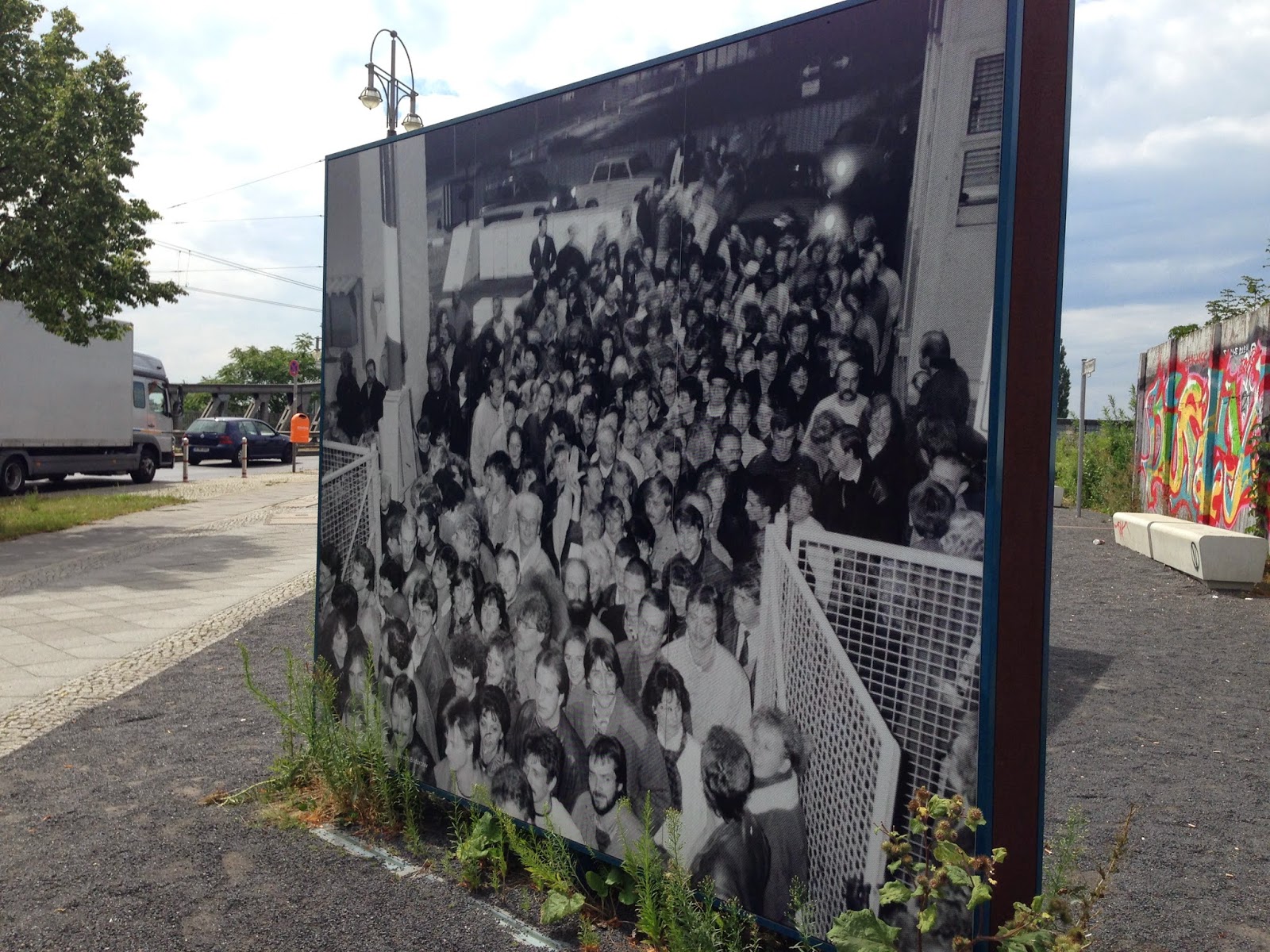Tuesday we visited the concentration camp Sachsenhausen. This camp felt much more like a concentration camp than Dachau did. At Sachsenhausen the grass was dying and sparse, the stones on the ground were uneven and broken, and all the buildings were old and dirty. I actually felt like this was a place where people had suffered, unlike Dachau which felt like a park. There was a memorial for and the base of the structure of the crematorium where over 10000 Soviet POWs were executed in 1941. There was also a memorial for when the camp was Soviet Special Camp No. 7/No. 1 during the Cold War.

Gate of Sachsenhausen
Memorial for Soviet Special Camp No. 7
Cafeteria inside Reichstag Building
Inside Reichstag building. This is where the committees meet
Each box represents a democratically elected member of Parliament
The black box represents the years of National Socialism, in which no Parliament members were democratically elected
Hitler's box - the artist's choice to include him as democratically elected was very controversial
Graffiti on walls inside Reichstag - from when building was in ruins during Nazi times
Angela Merkel's office
View of Parliament from dome
Dome on top of Reichstag
Sunset over Berlin from top of Reichstag
Sunset from dome of Reichstag building
Reichstag Building
German Chancellery AKA the Federal Washing Machine (looks like a front loading washing machine)
Day 16 - Cold War Walking Tour
Wednesday we took another walking tour of Berlin, this time emphasizing the Cold War. We walked along the remaining sections of the Berlin Wall and toured the Palace of Tears. We also visited the Stasi museum, which was the former headquarters of the Soviet Secret Police.
Berlin Wall Graffiti
Berlin Wall Graffiti
Checkpoint Charlie
Palace of Tears
"Berlin Wall 1961 - 1989"
The Berlin Wall stood here
View through Berlin Wall
When the wall came down
When the wall came down
When the wall came down
Erich Mielke's, the head of the Stasi (German Secret Police) desk
Thursday we walked through two old Jewish neighborhoods in Berlin. We saw a Jewish cemetery from before the war and several parks. We also walked to an old airport that is now a park in what used to be West Berlin. This airport was where the planes landed every three minutes bring supplies when West Berlin was cut off from the rest of West Germany.
Memorial to the Jewish women who protested in this square
Old Jewish Neighborhood
Jewish cemetary
Stumbling Stones - stones on the ground that represent people persecuted by the Nazis (usually Jewish or gypsies) who lived in the buildings they are outside
New Jewish synagogue
Represents German children sent away from war
Represents Jewish children being sent away
West Berlin Airport
Day 18 - Villa Wannsee
Today we visited Villa Wannsee where the Wannsee conference was held in 1942. The house (which is really quite pretty) was not made into a memorial until 1992. In fact, it was made into a youth hostel for a while. It was really interesting because instead of just walking through the exhibits, we had more of a seminar. After our guide explained some of the exhibits, we broke into groups and investigated different topics. I looked into a few events from the war (Moldavia mass executions, expropriations after the war, and the "Knee Fall" of German Chancellor Willy Brandt in the Warsaw Ghetto in 1970. The exhibits talked about the events of the war and then how the public was reacting years later when the events/trials/memorials were brought up again. I also got to read a translation of the minutes from the Wannsee Conference. It was really interesting to read; I had heard about it in history classes before but I had never read any part of it. I couldn't believe some of the ideas they had.
Villa Wannsee
Wannsee gardens
Wannsee gardens
Conference Room where Wannsee Conference (probably) held (may have been in the next room)
This last picture shows the mass execution of people in Dubossary, Moldavia on September 14, 1941 by Einsatzgruppen D Einsatzkommando 12b, a mobile killing squad of the SS. The picture shows soldiers lined up along a trench shooting the men, women, and children inside. In two weeks, between 6 and 18 thousand people were killed by Einsatzkommando 12b both in this way and by mobile gas chambers. Two members of this squad were brought to
trial in late 1974: Max Drexel and Walter Kehrer. Drexel was charged with murdering 2800 people
and being an accessory to the murder of 5390.
Kehrer, who did the actual loading of the gas vans, was charged with the
murder of 7800 people and as the accessory to a further 4000. Drexel was sentenced to five years in prison
and Kehrer to four. That is equivalent
to serving 5.28 and 2.88 hours in prison per person murdered respectively. The punishment wasn't anywhere near severe enough in my opinion.
It is the last picture of this post, so if you don't want to see it, stop here.
















































No comments:
Post a Comment